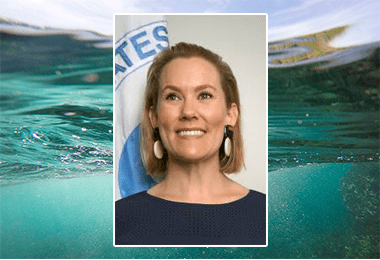Anne Idsal, EPA Administrator – Region 6
What are your priorities as US EPA Administrator for Region 6 with regard to water?
EPA Region 6 has a very diverse set of waterways and water priorities within and among our five states. Under Administrator Pruitt’s leadership, we are working to prioritize clean drinking water and safe waste water for the states in a way that addresses their individual priorities and goals. EPA looks forward to working with our state partners to help eradicate lead from drinking water; create collaborative pathways to remediate impaired waters; and work with stakeholders and communities to ensure that we continue to protect human health, the environment, and the economy.
Your experience in Texas includes the General Land Office and the Texas Commission on Environmental Quality. What advantages/disadvantages does that create for your new position at EPA?
I come into the position as a proud, multi-generational Texan and as someone who has worked in state government and understands it well. I like to think of it as an advantage, as my background allows me to see multiple sides of an issue or challenge given my time at the TCEQ and the GLO.
Region 6 covers more than just Texas. What strategies or aspects have worked for you in Texas that you plan to try in other states and how are you introducing yourself to Louisiana, Arkansas, Oklahoma, and New Mexico?
I have had the privilege of visiting all of the regional states within the first two months I started with the EPA. I believe it is critical to build relationships with state leaders to better understand their issues and make it abundantly clear that Region 6 stands ready to be an engaged and collaborative partner. I regularly visit with the environmental stakeholders in the Region, in person or over the phone, to discuss emerging challenges. Modeled after Administrator Pruitt’s leadership, I am committed to regular, open communication with states to earn their trust and promote relationships.
Given that many of the Region 6 activities surround industrial facilities along the Texas and Louisiana coasts, how is the Region 6 addressing the aftermath of Hurricane Harvey? How is Region 6 preparing for similar events in the future?
EPA sent over 240 staffers, including staff from Region 6, and did an outstanding job responding during and after Hurricane Harvey made landfall. Region 6 continues to re-assess its performance after Hurricane Harvey. We are pulling together lessons learned, working with our sister agencies within the region, and thinking outside the box to be proactive for the next event, whether it’s wind, fire, or flood related (or some combination thereof). We have to better engage local, state, and federal partners to ensure that when we respond next time we do it better, faster, and more efficiently. We also have to work with those same stakeholders to ensure that as we plan to recover in the long-term we do so in a way that focuses on improving and hardening our infrastructure and communities so we come back stronger than before.
What are you looking forward to most in your new position as Regional Administrator?
I am very excited by the opportunity to learn about new issues throughout Region 6 and engage with Texas’ sister states and tribal communities in a way I haven’t done previously. This Region is composed of entrepreneurial states that embrace a “can-do” attitude that promotes their flourishing economies, while simultaneously demonstrating track records of continued environmental improvement with an eye on the prize of environmental excellence.

